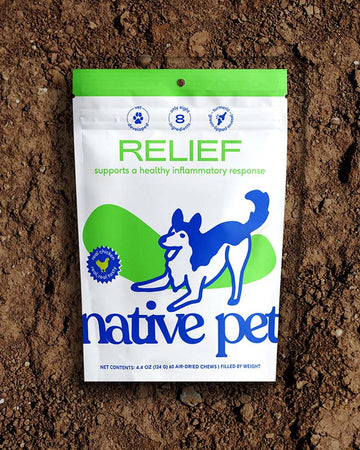By: Dr. Juli, DVM @itsDrJuli
Calling all pet parents whose dogs are named Nike, Garmin, Pacer, or Prancer: you're in the right place. If running only enters your mind as a reaction to being chased, you have also found the article just for you (and your favorite four-legged cuddle buddy). For some people and pets, exercise, especially running, is a lifestyle and just as routine as mealtime. However, running is the last thing on the to-do list of daily priorities and activities for many two-legged and four-legged creatures.
Like humans, physical exercise is vital for pets to ensure their joints are adequately lubricated and they maintain a healthy weight. With more than 50% of U.S. dogs being overweight or obese, exercise is essential to your pet's health, wellness, and weight control. Exercising or running outside with your pup will also ensure your pet is mentally stimulated with exciting sights, smells, and sounds. Spending time together will strengthen your bond and get you both moving more.
As an avid ultramarathon runner, exercising with my dogs (Pacer and Stryder) was one of my greatest joys. Although they are no longer alive, the memories of sharing the trails with them and the lessons they taught will forever be etched in my heart and mind. I know, from first-hand experience, that starting a running routine with your pup can be challenging. Safety for you and your dog is paramount, so check out my go-to guide for determining if running is for you and your furry best friend.
Is Your Dog Meant to Be a Running Dog?
Most dogs love to run, and, like people, some dog breeds are built for long-distance running, like greyhounds, huskies, or working dog breeds. However, use caution when running with certain breeds, especially brachycephalic dogs, including pugs and bulldogs. Brachycephalic breeds have narrow nostrils and flatter faces, making breathing difficult during exertion. This means they are prone to overheating. Additionally, a little dog or a dog who has short legs, like a dachshund or corgi, may have difficulty keeping up with its human exercise buddy.
Temperament and desire are also critical when deciding if your pup would make a good running buddy. During outdoor adventures or daily potty walks, if your dog typically growls at others or fears pets and people, bringing them for a daily run may not be a good fit. Running with your dog requires a well-mannered, socialized pet because they will be exposed to many sights, sounds, people, and potential wildlife during your daily run. Taking an unsocialized pet on extended running excursions could induce stress and lead to accidents or dangerous interactions with others. If your dog is more like a 'fraidy cat, choosing activities close to home is a better exercise option.
In addition to breed and temperament, age is critical when determining the right time to start running with your dog. Puppies with developing bones and organs should not participate in a rigorous exercise program. Depending on the breed, a dog's musculoskeletal system is not fully developed until between 8 and 22 months. As a general rule, wait to start training your dog to run until they are a year and a half old to decrease their injury risk. Older dogs are also at risk of injury - we recommend working with a canine rehabilitation specialist to ensure your senior pup is ready for long-distance running. Some breeds, like German shepherds, have an increased risk for hip dysplasia, making it too painful to run extended distances.

Benefits of Running with Your Dog
Like humans, pets require daily mental and physical exercise for overall health and wellness. Running will also help maintain your dog's weight, which is critical for preventing diabetes and arthritis. Other benefits of running with your dog include the following:
- Bonding. Designating time each day to run with your pup will strengthen the bond with your four-legged best friend.
- Mood boost. Daily exercise and spending time with your pet are two of the most potent mood-boosting activities for people. Your pet equally benefits from quality time with their favorite human, making running together a win-win for all.
- Boredom prevention. A daily run with your dog will help prevent boredom and associated destructive behavior or anxiety. Running outside allows your dog to experience new sights, smells, and sounds that exercise their mind while moving their body.
- Accountability. For many people, the most challenging part about starting a running routine is taking the first step. However, once your furry pal becomes your running buddy, it can aid in establishing an exercise regimen for you and your pet. Pets, like people, thrive on routine, so ensure not to disappoint your canine running partner and lace up those running shoes and paws.
How to Start Running with Your Dog
Before starting a running routine with your dog, take them for a veterinary examination to ensure they are fit to run. Your veterinarian will check for any underlying health issues and ensure they have the temperament and health to participate in a running program. Additionally, ensure your pet's microchip is functioning and registration current in case your pup accidentally heads out for an unplanned solo running adventure. Other tips to start running with your dog include:
- Walk before (and after) you run. Ensure your pup has a chance to warm up and cool down their muscles, sniff, and eliminate before and after running.
- Go slow. Give your dog time to get used to running with you, and never pull, force, or ask them to sprint when you are out for a run. Gradually increase the distance by a half-mile each week until you reach the desired total length or your pup signals that they have had enough.
- Take frequent breaks to walk and hydrate. Hydration is vital when participating in any physical activity. Never feed your pup human electrolyte drinks. Take regular breaks to allow them to drink water and rest.
- Teach basic commands. Good doggy manners are essential to prevent injuries or accidents. Ensure that your pup knows basic commands, including sit, stay, and leave it, when they are on and off-leash.
- Don't let your pup pull you. Large dogs and dogs who are balls of energy, like Jack Russells, Border Collies, or labrador retrievers, may want to hit the ground running, literally. But never allow your running buddy to pull you. Teach your dog to walk and run while remaining by your side. Your pup's nose should be even with your knees, and your arm should be relaxed, holding their leash at the level of their collar.
- Hit the trails – Soft dirt or grass trails are easier on your dog's feet and joints than sidewalks and pavement. Trail running also provides beautiful scenery and exciting smells and sounds for you and your pup.
Dog Running Gear Essentials
Running gear is not just for people anymore. Ensure your dog has the proper equipment for a comfortable and safe run before heading outdoors. Your dog's running gear should include the following:
- A 4-6 foot fixed-length leash (never use a retractable dog leash!)
- A properly fitted collar with identification
- A collapsable water bowl
- Paw protection (if the surface is too hot or cold for you to walk barefoot, it's equally dangerous for your pup!)
- Winter jacket for cold weather
- Poop bags

General Tips and Key Takeaways for Running with Your Dog
Running with your dog can be a fun and safe way to exercise and bond with your furry friend. Never punish or force your dog to run; always praise them for good behavior and manners. A happy dog will be more likely to behave appropriately indoors and outdoors. Follow these tips to ensure everyone remains happy, healthy, and safe while on the run:
- Never run your dog during extreme weather. Avoid going outside during peak heat or cold temperatures. Monitor your dog for signs of overheating or hypothermia, and immediately seek veterinary care if you notice them struggling.
- Don't feed your dog a meal immediately before or after running. Ensure your pup is no longer panting and is properly cooled down before offering a meal or snack.
- Feed your dog an AAFCO-approved diet for their age and breed to ensure they receive the required vitamins and minerals for proper organ function.
- Support your dog's mobility with joint supplements.
- Ensure your dog is adequately hydrated. Ice cubes made with Bone Broth are the perfect post-run hydration treat.
- Ensure your pup's vaccinations are current and they receive a veterinary-prescribed parasite prevention medication to avoid hitchhiking pests while on the run.
- Only allow your dog to run off-leash where it is safe and legal. Only take your dog off leash if they are trained with voice commands.
For more information on your dog's health, check out the Native Pet blog.









